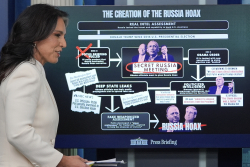The artificial intelligence boom’s energy demand requires guardrails instead of only power to create a sustainable future.
The artificial intelligence (AI) boom is transforming sectors from agriculture and manufacturing to law and healthcare while also introducing fast-moving risks, including energy system impacts that could complicate decarbonization. But with this risk comes a unique opportunity to accelerate decarbonization—provided industry leaders, policymakers, and communities act together.
AI’s explosive energy demand could sharply raise carbon emissions. The growth of data centers accounts for much of AI’s energy demand. These facilities run twenty-four/seven to process data and require major power and cooling. Cell towers, switches, and routers also add to AI’s overall energy footprint.
Given its rapid ascent along a steep growth curve, the AI sector could join the ranks of the most carbon-intensive sectors, including heavy industry. Many AI firms pledge clean energy sourcing—but in rushing to meet demand, the sector risks monopolizing it.
AI’s pace of growth is unique. The volume of demand, if fully provisioned from existing clean energy assets and a pipeline of new sources, would constrain the supply for other energy consumers, who cannot match the astounding balance sheets of AI firms and the demonstrated willingness to pay premium prices for clean energy assets. The resulting constraint on supply would lead to increased marginal costs for clean power provision outside the AI sector, shifting burdens onto residential ratepayers, smaller businesses, and hard-to-abate sectors that already face considerable obstacles to decarbonization.
This prospect forces a critical question: Will AI become a bottleneck or a breakthrough for the clean energy transition? Developing clean power sourcing for AI is a big challenge that requires commitment from the sector, but the bigger challenge (and unique opportunity) is doing so in a manner that charts a just path for wider decarbonization. If the sector commits to tackling the second challenge, it can transform an existential risk into a massive social and economic boost for decarbonization—essentially enabling one revolution, in clean energy, with another, in AI.
Thanks to unique natural advantages, the AI sector is positioned to accelerate the clean energy transition in ways few other industries can match. First, the need for strategic sequencing of increases in capacity as data centers come online, coupled with the sheer energy density of these facilities, acts as an inherent forcing mechanism for meticulous pre-planning. Developers must secure power far in advance—offering early opportunity to integrate clean energy.
Second, siting options for data centers are unusually flexible. Consider that transportation and logistics hubs must locate near cities, ports, or highway networks; refineries must locate near shipping channels or ports; and many infrastructure systems must nest within large power corridors. Other developers compete for limited, expensive real estate. Data centers face fewer siting constraints. This flexibility grants developers freedom to avoid locations where development could negatively impact the surrounding area, such as through traffic pattern changes, power grid congestion, negative effects on the local tax base, or damage to delicate ecosystems.
Taken together, these characteristics create opportunities for intentional planning with fewer objectionable tradeoffs. The industry’s current corporate structure confers advantages as well. The AI sector is concentrated among a few dominant firms. With fewer major players, AI’s concentrated leadership enables streamlined decisions on large-scale clean energy procurement, facilitates the rapid adoption of industry-wide sustainability standards, and empowers direct, impactful collaboration with grid operators and renewable energy developers.
The sector’s concentration and collective financial strength provide an opportunity for AI to drive systemic change across the energy landscape. However, to ensure that these inherent advantages translate into widespread public benefit, a structured approach for responsible energy development must be established.
A framework for responsible energy development should begin with industry standards for power sourcing and siting that avoid exacerbating grid constraints and clean power scarcity. Such a standard should also identify low-impact, high-benefit locales for collocating data centers and clean power and provide guidance for prioritizing locations that improve grid performance and unlock broader clean energy benefits. It is also critical that standards include provisions ensuring that projects bring sustained local tax and economic gains.
The importance of public buy-in will grow as projects begin to queue. A responsible clean power standard is a great first step toward earning public trust. However, the industry needs to adopt a model demonstrating ongoing commitment to responsive community engagement. The model should rest atop responsible sourcing and siting standards and ensure earnest engagement throughout the process—from site selection and assessment of a project’s demands on local infrastructure to the evaluation of the technological footprint (scale, design, and operations) to agreement on the public benefits to be delivered (e.g., tax base contributions, economic development, environmental stewardship, and workforce opportunities).
The sooner, the better. Communities have been burned before by infrastructure projects failing to deliver on promises, from sports stadiums to manufacturing hubs to corporate HQs. AI can chart a better path—turning their energy footprint into climate progress.
About the Authors: Erik Funkhouser and Nora Ankrum
Erik Funkhouser is the executive director of Good Energy Collective. From 2013 to 2018, Erik was an executive researcher and strategic advisor specializing in climate technology market research. His expertise includes emerging technology market development, market transformation, and design and implementation of research, development, and demonstration (RD&D) initiatives. His responsibilities included business model innovation for community-based renewable energy, developing market and policy strategies to reduce non-hardware “soft” costs, and exploring policy engagement opportunities in early-stage private finance for climate-mitigating technologies.
Nora Ankrum is the Strategic Communications Manager at Good Energy Collective, where she leads GEC’s communications strategy, oversees content development and brand positioning, manages media relationships, and facilitates strategic partnerships to drive GEC’s impact. Prior to joining Good Energy Collective, Nora served as Director of Special Projects at the Energy Institute at the University of Texas at Austin (UT Austin), where she facilitated strategic collaboration on cross-disciplinary initiatives to support energy literacy, education, and research. Nora has a Bachelor of Arts in English from UT Austin and a Master of Public Affairs from the LBJ School of Public Affairs at UT Austin, where she studied energy and environmental policy.
Image: Shutterstock/Deemerwha studio

















